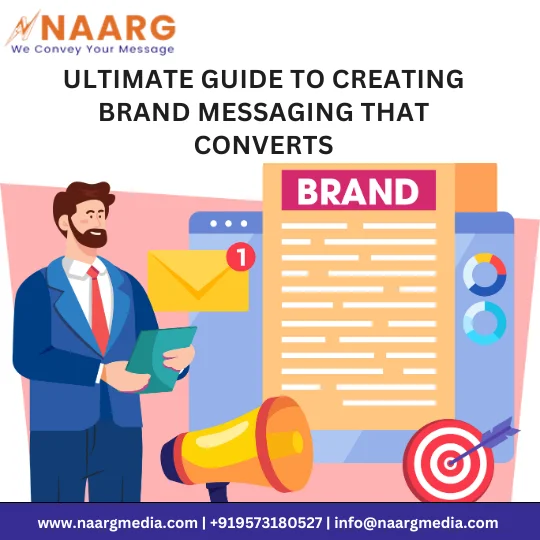Having a great product or service is not the only part of the equation for any business to succeed. Your target audience is bombarded with countless options daily, and the brands that capture their attention are typically those with clear, compelling, and consistent brand messaging.
It is equally crucial that you communicate your brand with your target audience. And this is where brand messaging comes into play. But what is brand messaging? It’s not just about creating catchy slogans or attractive taglines.
The main purpose of brand messaging is to have a deep understanding of your target audience and a clear articulation of your uniqueness and your brand’s unique value proposition.
Just take the example of Nike’s iconic ‘Just Do It’. These three words in the tagline encapsulate a powerful ethos of athleticism, determination, and empowerment. It’s not just about the tagline; it’s the message that not only speaks to professional athletes but to anyone, including people like you and me who strive to push their limits daily.
Want to understand how brand messaging can make your brand impactful? This blog will delve into the essential elements of brand messaging. In this blog, we will unravel the key elements of brand messaging and how to develop brand messaging. And most importantly, how to measure brand messaging effectiveness.

What is Brand Messaging?
Brand messaging is the core component of how your business communicates its unique mission, value proposition, and brand identity to the world. It’s all about the narrative that encompasses every touchpoint with your target audience, from social media posts to customer service interactions and marketing materials.
Effective brand messaging resonates with your target audience as it evokes emotional responses and inspires loyalty. Did you know that according to a survey by Statista,73% of customers are more likely to trust and buy from a brand they recognize?
Emphasizing the importance of genuine brand messaging in fostering strong customer relationships. Moreover, in a digital age where our target audience is more informed and discerning than ever, having compelling brand messaging is crucial for cutting through the noise and thus making a lasting impression.
Key Elements of Brand Messaging
Creating brand messaging that converts, generally involves several critical elements, each of which contributes to a compelling and cohesive message that resonates with your audience. Listed below are some key elements to consider:
1. Value Proposition
A value proposition is a promise of value that you deliver to your target audience. It explains why someone would choose your product over another brand. Having a strong value proposition highlights the benefits and solutions your brand offers.
For instance, you must have heard of Spotify’s value proposition, ‘Music for Everyone’, which communicates accessibility and a vast music library for individual preferences.
2. Brand Voice and Tone
The tone and voice of your brand convey its influence and personality on how your target audience perceives you. The brand voice somehow remains consistent, reflecting your core messages and values, but the tone of your brand varies depending on the context and your target audience.
3. Tagline
What is a tagline? It is a memorable phrase or slogan that encapsulates the essence of your brand. It should be catchy, short, and convey a key aspect of your value proposition.
Just like Nike’s tagline,’ Just do it’, it is a prime example of an effective tagline that inspires you to take action and reflects the brand’s athletic spirit.
4. Positioning Statement
A positioning statement defines how you want your brand to be perceived in the global marketplace relative to competitors. It specifically outlines the niche you occupy and the unique values you provide to your brand.
Having a proper positioning statement helps differentiate your brand and ensures that all your messaging aligns with your desired market position.
How to Develop a Brand Message?
Developing effective brand messaging requires a strategic approach and a deep understanding of your brand and target audience. Listed below are the steps to help you craft compelling brand messaging that resonates with your target audience and ultimately converts.
1. Understanding Your Audience
Always start by thoroughly understanding your target audience. For this, you need to conduct market research to gather insights into your target audience’s demographics, preferences, pain points, and behaviors.
Try to create detailed buyer personas to represent different segments of your audience. This particular understanding will help you guide the language, tone, and content of your brand messaging to ensure it resonates with your target audience.
2. Define Your Brand’s Core Values and Mission
Make sure to identify your brand’s core values and mission. And these core messages and values should reflect what your brand stands for, its purpose, and its long-term goals. Our brand’s core values and mission statements will serve as the foundation of your brand messaging, guiding all communication efforts.
3. Craft your Value Proposition
To craft your value proposition, you need to develop a clear and compelling value proposition that explains the unique benefits your brand offers. Your brand’s value proposition should address the specific needs and problems of your target audience, explaining how your brand provides a better solution than your competitors.
4. Develop Your Brand’s Voice and Tone
Always determine the voice and tone of your brand that best represents your brand’s personality and values. The brand voice of your brand should remain consistent across all platforms, whether it’s casual, formal, playful, or authoritative.
The tone of your brand can vary based on the context, but it should always align with your brand voice.
5. Create Your Brand Story
Always craft a compelling brand story that particularly highlights your brand’s journey, mission, and the impact you aim to make. Your brand story should always be authentic, emotionally resonant, and engaging.
You can use storytelling techniques to humanize your brand and also create a connection with your target audience. Moreover, a strong brand story not only communicates your brand values but also builds trust and loyalty.
6. Ensure Consistency Across All Channels
Make sure your brand message is consistent across all channels. Consistency is crucial for effective brand messaging. You need to ensure that your messaging is consistent across all touchpoints, including your social media, website, email marketing, and customer service interactions.
You can use style guides to maintain uniformity in tone, voice, and visual elements.
Measuring Brand Messaging Effectiveness
To measure the effectiveness of your brand messaging, it is crucial to look for key metrics and methods to evaluate the impact of your brand messaging.
1. Brand Awareness
With the help of brand awareness measures, you can analyze how familiar your target audience is with your brand. For this, you can conduct surveys and polls to assess brand recognition among your target audience.
You can track mentions, hashtags, and even shares on social media platforms to gauge how often your brand is being discussed.
2. Engagement Rates
With the help of engagement rates, you can analyze how well your audience is interacting with your brand messaging. For this, you can use methods to track likes, comments, shares, and clicks on social media platforms.
You can take advantage of tools like Google Analytics to measure page views, session duration, and bounce rates for content-related activities.
3. Conversion Rates
With the help of conversion rates, you can measure the percentage of your target audience taking a desired action, like making a purchase, signing up for a newsletter, or downloading a source.
You can also track sales and revenue metrics to determine how effectively your brand messaging drives purchases. You can also monitor the number of leads generated through landing pages, forms, and other calls to action.
4. Customer Feedback and Sentiment
Customer feedback provides insights into how your target audience perceives your brand messaging. You can collect feedback through customer surveys, reviews, and testimonials to understand their experiences and perceptions.
Also, you can use a sentiment analysis tool to analyze social media comments, reviews, and other user-generated content for positive or negative sentiments.
Crafting brand messaging that converts is a nuanced blend of art and strategy. Understanding your target audience, defining your core message and values, and consistently communicating your unique value proposition can create a powerful brand narrative for your brand that resonates with your target audience and impacts action.
So, are you ready to elevate your brand messaging and make a lasting impact? You can start by implementing the strategies outlined in this blog.
We are Naarg, a global language services provider that supports various businesses in reaching a global audience in any language.
Contact us today to learn more about our services.

